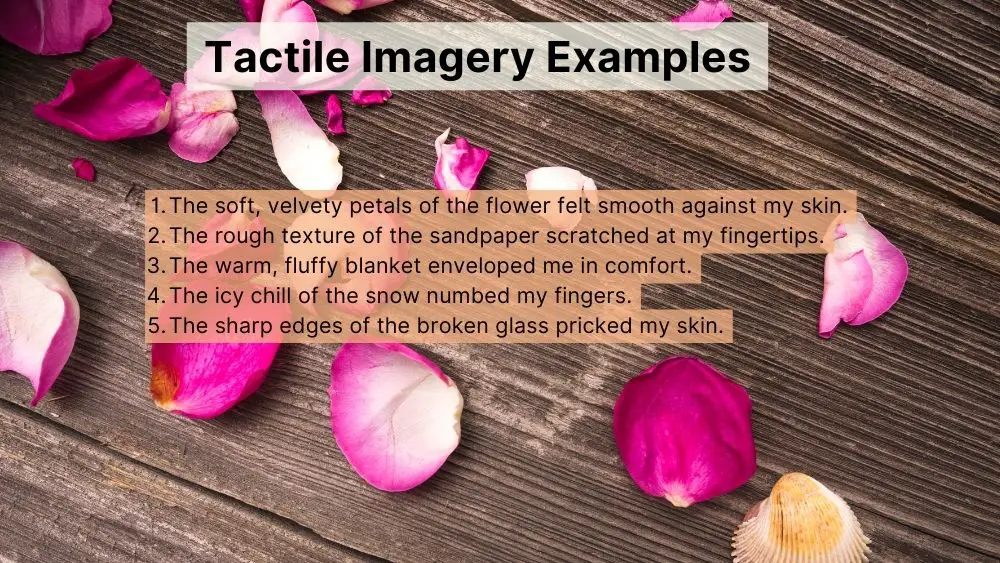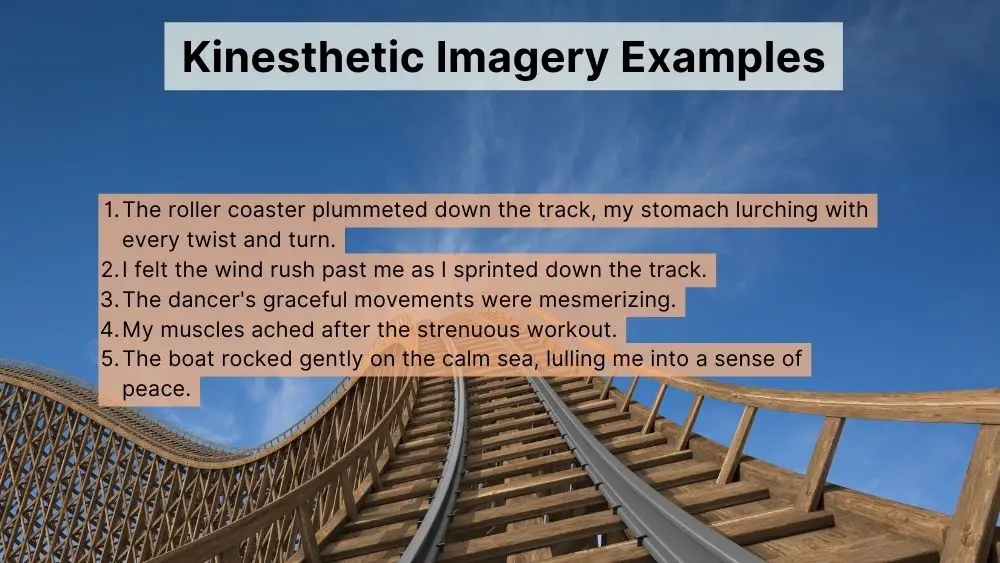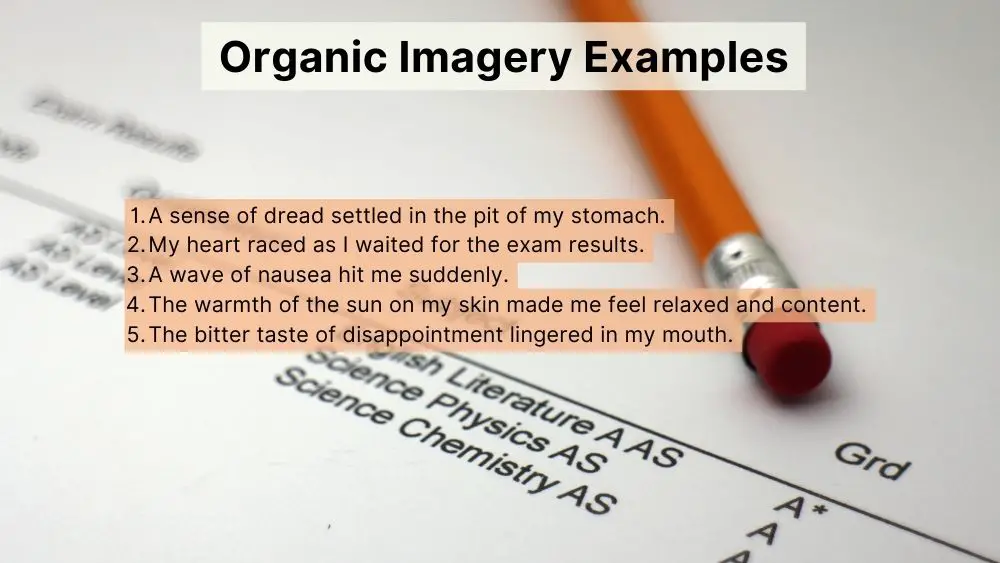Imagine you’re flipping through the pages of a book, and suddenly, you’re not just reading – you’re right there in the story. The secret? Imagery, my friends. It’s a literary device that writers have up their sleeves to transport us to worlds beyond our imagination.
So, what exactly is imagery?
Simply put, it’s using descriptive language to evoke feelings and paint a picture in your reader’s mind.
Think of it as painting, but instead of brushes and paints, you’re using words. And why is it so powerful in storytelling and creative writing?
Because it makes the story or message stick.
When you read a book or an article and can almost see, hear, or feel what’s being described, that’s imagery at work.
It’s not just about making writing pretty; it’s about making it memorable and engaging. When we read a vivid description, our brains light up as if we’re actually experiencing what we’re reading.
This isn’t just cool; it’s crucial in keeping us hooked. We’re creatures of sensation, and when a writer can tap into our senses, they’ve got us right where they want us – deep in the heart of their narrative.
But here’s the catch – not just any description will do. The trick is to use the right words in the right way. You want your reader to feel like they’re part of the scene, not just an outsider looking in. It’s about finding that sweet spot between saying too much and not saying enough.
In business writing, or any writing for that matter, mastering imagery is like unlocking a new level of engagement. Whether you’re penning an article, crafting a business proposal, or spinning a tale, imagery pulls your reader closer, whispering, “See what I see, feel what I feel, embark on this journey with me.”
Visual Imagery
Imagine you’re settling down into the cozy, slightly worn seat of a movie theater. The screen flickers to life, and suddenly, you’re not just a spectator; you’re right there in the story. This magic? It’s not just for movies. It’s what happens in your head when writers use visual imagery. This tool lets authors create a picture so vivid and colorful in your mind that you feel like you’re watching a heart-pumping car chase or strolling through a sun-soaked meadow without ever leaving your room.
So, how do they do it? Let’s zoom in:
Painting Scenes:
Picture the sunset. Not just any sunset, but one that bathes the sky in a symphony of pink, orange, and gold, turning the clouds into fiery cotton balls. When writers describe a scene with such precision and color, your mind’s eye projects it as clearly as if it were on a big screen.
Crafting Characters:
Think about meeting someone new in a story. With the right words, this person springs to life, from the twinkle in their eye indicating they’re up to something to the way they tap their foot impatiently. Suddenly, they’re not just words on a page; they’re as real as your best friend.
Action!:
Imagine reading about a thrilling car chase. The author’s choice of words can make your heart race, your palms sweat, and your eyes dart across the page to find out what happens next. That’s visual imagery at work, making you feel like you’re in the passenger seat, hanging on for dear life.
At its core, visual imagery is about making readers see what they cannot see. It’s a kind of magic that turns black-and-white text into a technicolor experience, bridging the gap between imagination and reality. Not only does it make stories more enjoyable, but it also draws you deeper into the world the author has imagined.
Whether it’s the eerie darkness of an abandoned house casting shadows in your mind, or the bustling, colorful streets of a faraway city you can almost see, visual imagery is the key to bringing stories off the page and into your mind’s theater.
So, the next time you dive into a good book, pay attention to how the author uses visual imagery to invite you into the story. It’s like getting a front-row seat to the movie of your imagination!
Visual Imagery Examples:
- The sun set behind the mountains, painting the sky in shades of orange and pink.
- The lush green meadow was dotted with vibrant wildflowers in every color.
- A tall, majestic waterfall cascaded down into a crystal-clear pool.
- The old library was filled with rows of dusty, leather-bound books.
- A single red rose stood out in the otherwise barren garden.
Auditory Imagery
Welcome to the fascinating world of auditory imagery, a unique realm where writers masterfully craft sentences to tickle your inner ear. Have you ever gotten lost in a book, only to realize you’re hearing the sounds described on the page as if they were happening right next to you? That’s the magic of auditory imagery at work.
Imagine this: you’re engrossed in a story and suddenly, you’re not just scanning words; you’re listening to the soft murmur of a stream, the sharp crack of thunder, or the soothing whisper of the wind through the leaves. Writers use this technique to pull you deeper into their world, making the experience all the more real and immersive.
Let’s explore a few ways authors conjure this aural magic followed by some examples of imagery that is auditory.
1. Onomatopoeia:
This is when words mimic the sounds they describe, like “buzz” or “thump.” It’s as if the sounds leap off the page, creating a soundscape that surrounds you.
2. Dialogue:
Through the conversations between characters, writers can convey tone, emotion, and so much more. It’s like you’re eavesdropping on real-life conversations, hearing the laughter, the cries, and the whispers.
3. Descriptive Language:
By describing sounds in detailed, vivid language, authors can make you hear things in your mind’s ear. For example, the relentless pounding of rain on a tin roof can be so well described that you find yourself almost reaching for an umbrella.
4. Rhythmic Writing:
Similar to music, the rhythm of sentences can mimic the cadence of real-life sounds, from the steady gallop of horse hooves to the gentle patter of raindrops on a window.
But why do writers put so much effort to create imagery that is auditory? Well, it’s all about creating a connection. When you hear what the characters hear, the story feels closer, more personal. It’s one thing to read about a character walking through a bustling city; it’s another to hear the cacophony of car horns, shouting vendors, and distant laughter right along with them.
Incorporating auditory imagery doesn’t just make stories more engaging; it makes them more memorable. The sounds we “hear” in a story can evoke emotions, remind us of our own experiences, or simply leave a lasting impression that keeps the story alive in our minds long after we’ve turned the last page.
So the next time you dive into a book and find yourself startled by a sudden “crash!” or soothed by the gentle lull of waves against a shore, take a moment to appreciate the artistry of auditory wrapped up in words. It’s a testament to the power of storytelling and the incredible ability of writers to create worlds that are not only seen but also heard.
Auditory Imagery Examples:
- The birds chirped melodiously in the early morning.
- Thunder rumbled in the distance, growing louder with each passing second.
- The soft hum of the air conditioner provided a constant background noise.
- Leaves rustled underfoot as we walked through the forest.
- The sound of waves crashing against the shore was soothing.
Olfactory Imagery
Ah, the olfactory imagery—now that’s where the magic of storytelling gets really personal. It’s all about scents and sensibility, my friends. When writers dive deep into the toolbox of imagery, they often pull out the power of smell to add that extra layer of reality to their work.
Imagine walking into a room and being hit by the smell of freshly baked cookies. You’re not just in any room; now you’re in grandma’s kitchen, aren’t you? That’s olfactory imagery at its finest. It’s fascinating, truly, how a simple description of a scent can whisk you away to a different place or time, or even tug on the heartstrings by reviving memories long forgotten.
Let’s talk particulars. When a writer describes the pungent smell of wet earth after a rainstorm, you’re right there, feeling the moisture in the air, aren’t you? Or when a character in a story walks past a café, and the air is thick with the aroma of roasted coffee beans, you can almost taste that first sip of coffee, can’t you?
Exploring the ways in which descriptions of smells can transport you has got to be one of the most underrated, yet powerfully evocative parts of storytelling. It’s about more than just setting the scene; it’s about touching the very core of the reader’s sensory experiences, reviving memories, and evoking emotions.
This sensory journey doesn’t just add depth to the narrative, it breathes life into it, making the story world more tangible, more real. And it’s these kinds of details that often stick with you long after you’ve turned the last page.
Remember, whether you’re reveling in the nostalgic scent of old books or bracing against the sharp tang of sea air, engaging the sense of smell in storytelling is a direct pipeline to the reader’s emotions and memories. Crafted carefully, olfactory imagery is a potent tool in any writer’s arsenal, capable of transforming words on a page into a vivid sensory experience. So the next time you sit down to write, think about the smells surrounding your scene, and watch as your world leaps off the page and comes alive in the minds of your readers.
Olfactory Imagery Examples:
- The scent of freshly baked bread wafted through the kitchen.
- The pungent smell of garlic filled the air as it sizzled in the pan.
- The fragrant aroma of blooming roses was intoxicating.
- The sharp, tangy smell of lemons lingered in the room.
- The musty scent of old books filled the small, dimly lit attic.
Gustatory Imagery
Imagine biting into a crisp apple. Can you almost taste its juiciness and feel its crunch? That’s gustatory imagery for you. We’re about to dive into how authors sprinkle their writing with words that tickle our taste buds and make our mouths water, all without a real bite taken.
When writers use gustatory imagery, they’re not just listing ingredients of a dish; they’re inviting us to a feast of imagination. It’s like when a character in a story savors a spoonful of warm, cinnamon-spiced apple pie. The description isn’t merely about what’s happening. It’s painting a flavor-rich picture that you can almost taste, right? You’re there, in that cozy kitchen, enjoying the pie along with the character.
But it’s not all sweets and treats. Authors might also use this kind of imagery to make a point or to add depth to a scene or character. Imagine a scene where a character tastes something bitter. That bitterness could reflect their feelings or the tone of the situation. Clever, right?
Gustatory imagery is a fantastic voyage. It’s not just about fancy dishes at a grand meal. It can be as simple as the reflective moment with a cup of hot chocolate on a rainy day, the tension of a family dinner, or the intimacy of sharing a homemade meal. Through these descriptions, writers build connections and evoke emotions. It’s pretty amazing how a few well-chosen words about taste can add so much flavor to a story.
So, next time you’re reading and come across a passage that makes you almost taste the words on the page, take a moment to appreciate the skill it takes to create that effect. And who knows? It might inspire you to whip up a dish or two, trying to capture those flavors in real life. Cheers to the writers who make our reading experience a full-course meal!
Gustatory Imagery Examples:
- The tangy taste of the lemonade was refreshing on a hot day.
- The rich, creamy chocolate melted in my mouth.
- The spicy chili left a warm, tingling sensation on my tongue.
- The tartness of the green apple made my mouth pucker.
- The savory flavor of the roasted chicken was mouthwatering.
Tactile Imagery
This special kind of imagery is like a secret handshake between the writer and the reader, where a simple phrase can transport you to a realm where you can almost physically touch the surroundings just by floating through sentences.
Tactile imagery is all about textures and sensations. Let’s break it down: Imagine you’re holding a cup of hot cocoa on a chilly evening.
The warmth seeps into your palms, doesn’t it?
That’s exactly what tactile imagery aims to achieve.
It uses words to replicate the feeling of warmth, cold, the roughness of a rope, or the smoothness of silk against your skin. It’s the touch that tells tales. It has a feel of poetic imagery that paints a strong mental image in the reader’s head.
When writers wield this style, they bring their stories to life in a very physical way. For instance, describing a character trudging through a blizzard, with mentions of how the icy wind bites at their cheeks, can make you involitarily shiver, right? Or consider the description of walking barefoot on a sun-warmed pathway; you might just feel the heat tickling your own feet.
Here are a couple of examples to illustrate tactile imagery further:
- As she wrapped the woolen scarf around her neck, she could feel the softness hugging her, offering a gentle caress against the harsh winter wind. The scarf wasn’t just an accessory; it was a barrier between her and the biting cold.
- The old wooden bench was rough under his hands, splinters threatening to prick his skin if he moved too swiftly. It spoke of years of exposure to the elements, each groove a testament to its endurance.
What makes these examples poignant is not just their ability to describe a sensation but their capacity to evoke a physical response in the reader. It’s almost as if, by describing the physical sensation so vividly, the story itself reaches out and touches the reader, creating a connection that’s tangible.
Incorporating tactile imagery isn’t just about bombarding the reader with a list of textures. It’s about choosing the right moments to enrich the narrative, making sure that every touch, every sensation, adds depth and authenticity to the story. It’s akin to an artist choosing the right stroke or color to bring a painting to life.
Remember, the goal is to make readers not just envision but feel the world you’re describing. So, when you sit down to pen your next story or describe a scene, think about how you can engage the sense of touch. Consider the roughness of tree bark, the slipperiness of wet marble, or the embracing warmth of a sandy beach under the summer sun. These details do more than paint a picture; they ensure your writing resonates on a deeply human level, connecting with readers in a way that’s both profound and tactile.
Tactile Imagery Examples:
- The soft, velvety petals of the flower felt smooth against my skin.
- The rough texture of the sandpaper scratched at my fingertips.
- The warm, fluffy blanket enveloped me in comfort.
- The icy chill of the snow numbed my fingers.
- The sharp edges of the broken glass pricked my skin.
Kinesthetic Imagery
Have you ever felt your heart race while reading about a thrilling chase scene, or found yourself swaying in your seat as you visualize a dancer’s fluid movements on the page?
That’s kinesthetic imagery at work, friends! By painting pictures of motion and action, writers can inject a scene with energy and excitement, keeping us hooked and eager to see what happens next.
Let’s leap into how descriptions of movement bring stories to life and get our own imaginations jogging.
When authors master the art of kinesthetic imagery, their words do more than just tell a story; they allow us to experience the story’s physicality.
Think about the last time you were engrossed in a book and found yourself tensing up during a suspenseful moment or feeling a surge of adrenaline during an action-packed sequence. That’s the power of well-crafted movement imagery at play.
Illustration Through Activity:
Imagine a character sprinting across a crowded marketplace, dodging vendors and leaping over obstacles. The writer’s choice of verbs and adverbs here creates a vivid portrayal of the urgency and agility of the moment.
Dynamism in Dialogue:
Even dialogue can benefit from kinesthetic imagery. Through the actions of fidgeting, pacing, or gesturing, we glean insights into a character’s emotional state or intentions, effectively adding a layer of depth to conversations.
Mood and Atmosphere:
The way an environment is described can also convey movement. Picture a serene lake with water gently lapping at the shore, versus a turbulent sea with waves crashing violently. Each setting evokes a different emotional response, courtesy of the movement within the scene.
By integrating descriptions of physical actions and movements, authors can make their narratives more engaging and immersive. Whether it’s the tense anticipation of a hidden threat or the exhilarated rush of a victory dance, kinesthetic imagery allows readers to move in step with the characters and feel the pulse of the narrative.
To breathe life into your own stories, consider how your characters interact with their surroundings and each other. Capture the whirlwind of a bustling city, the meticulous preparations for an elaborate heist, or the grace of a ballet dancer’s pirouette. Remember, the goal is to keep your readers on their toes, always anticipating the next move.
In conclusion, kinesthetic imagery is like a dance between the writer and the reader, where each sentence propels the story forward and invites us to feel every leap, twist, and turn. By harnessing the energy of motion, we enrich our narratives and give our readers an experience worth every moment of the journey.
Kinesthetic Imagery Examples:
- The roller coaster plummeted down the track, my stomach lurching with every twist and turn.
- I felt the wind rush past me as I sprinted down the track.
- The dancer’s graceful movements were mesmerizing.
- My muscles ached after the strenuous workout.
- The boat rocked gently on the calm sea, lulling me into a sense of peace.
Organic Imagery: The Inner Sensations
Picture this: You’re reading a story, and suddenly, you’re right there with the characters.
You’re not just seeing what they see or hearing what they hear; you’re feeling what they feel inside. This, my friends, is the magic of organic imagery. It’s all about the internal stuff, the sensations and feelings that swirl inside us. Think about the flutter of excitement in your belly before a big moment, or the heavy weight of sadness pulling on your heartstrings. That’s what we’re diving into today.
Organic imagery taps into our own, very human experiences. It’s like the author has a special key to our emotions, turning them on and off with their words. This type of imagery is super powerful because it connects with everyone on some level. Whether it’s a punch of fear, a surge of happiness, or the aching of loss, we’ve all been there.
When characters go through emotional rollercoasters or physical sensations – like a pounding heart before giving a speech or the warmth spreading through their body by a cozy fire – we’re right there with them.
And it doesn’t stop at emotions.
Organic imagery also covers physical sensations, like hunger, thirst, or tiredness. It’s about anything that stirs up something inside the characters, which in turn stirs something inside us, the readers.
Here’s why it’s a big deal: Organic imagery adds a towering layer of realism to stories. Characters feel more alive, more real, because their experiences mirror our own. When characters feel things deeply, we do too. It’s like we’re living the story, not just reading it.
But how do you spot organic imagery? Look for descriptions of internal feelings or bodily sensations. Phrases like “butterflies in the stomach,” “heart sinking,” or “lump in the throat” are your clues. These are signs the writer is drawing you into the character’s personal experience, making you feel right at home in their skin.
To sum up, organic imagery is the secret sauce that makes stories taste real. It’s the heartbeat of storytelling that pumps life into characters and connects them to readers. By exploring the inner sensations that characters experience, stories gain depth and become more relatable. So next time you’re lost in a good book, pay attention to those feelings it stirs up. That’s organic imagery at work, making sure you’re feeling every twist and turn right alongside the characters.
Organic Imagery Examples:
- A sense of dread settled in the pit of my stomach.
- My heart raced as I waited for the exam results.
- A wave of nausea hit me suddenly.
- The warmth of the sun on my skin made me feel relaxed and content.
- The bitter taste of disappointment lingered in my mouth.
The Impact of Imagery on Reader Experience
Alright, let’s dive into an exciting part of our journey through the colorful world of writing. Imagine you’re walking into a room that’s painted from floor to ceiling with scenes from your favorite book. How does that make you feel? This is the power of imagery at work, transporting you into a universe crafted purely from words.
Imagery goes beyond just painting a pretty picture. It’s like the secret sauce that grabs your attention and makes you feel like you’re right there in the story. Think about when you read a book, and you can almost smell the salty sea air or hear the bustling sounds of a city street. That’s because of effective imagery, which engages all your senses, making the experience truly immersive.
When writers use different types of imagery – from visual snapshots to the textures you can almost feel beneath your fingertips – they’re doing more than just telling a story.
They’re creating an experience that sticks with you, making the story more vivid and memorable. It’s like they’re building a bridge between the words on the page and the movie in your mind’s eye. This bridge is what sets a good story apart from a great one.
Why does this matter? Well, as readers, we crave connections, not just with characters or plots, but with the very essence of the story.
When a writer successfully uses imagery, they’re gifting us a ticket to ride alongside the characters, to live in their world, even if just for a while. It makes the difference between reading a series of events and really experiencing them.
And here’s the kicker: imagery doesn’t just make stories more enjoyable. It also helps us, as readers, to remember them. Ever wonder why you can recall specific scenes from a book years after reading it? Chances are, those scenes were rich in imagery, touching your senses in a way that etched them into your memory.
So, the next time you pick up a book or write your own story, pay attention to the imagery. It’s the key to unlocking a deeper, more thrilling reader experience. Whether you’re exploring new worlds or uncovering hidden aspects of our own, imagery turns reading into a journey where every page is a new adventure. Keep that in mind, and let’s continue to explore the magic of stories together.
Crafting Powerful Imagery: Tips and Tricks
Let’s roll up our sleeves and dive into crafting imagery that makes your writing shine. Imagine you’re painting, but instead of a brush, you have words. How cool is that? Here, we’ll uncover some practical ways to sprinkle your stories and descriptions with vivid imagery, making everything leap off the page.
1. Start with Specificity:
The magic is in the details. Instead of saying “the bird,” describe the “scarlet cardinal perched on the frost-covered branch.” It’s about painting a picture so clear, your readers can see it in their minds.
2. Engage the Senses:
Remember, we’ve got five senses. Use them! Describe the crackling sound of leaves underfoot, the tangy taste of a lemon, the scent of rain on concrete, the chill of a cold breeze, or the softness of an old, worn-out book. This helps your reader dive headfirst into your world.
3. Use Figurative Language:
Metaphors and similes are your friends. They compare the unfamiliar with the familiar, making your descriptions more relatable and engaging.
Saying something “glitters like a thousand tiny stars” immediately puts vivid figurative imagery in the reader’s mind.
Figurative language imagery adds colors and strong depth to any story or article and is one of those literary devices that can really up the reader’s imagination.
4. Avoid Clichés:
Yes, clichés are easy to grasp, but they’re the nemesis of originality. If you’ve heard it a million times, so have your readers. Challenge yourself to find fresh, unique ways to describe common scenes or feelings.
5. Vary Your Sentence Structure:
Mixing short, punchy sentences with longer, more descriptive ones can create a rhythm that keeps the reader engaged. It’s like music; you want to have a beat that carries your readers through the story.
6. Be Mindful of Your Audience:
Always keep the reader in mind. If you’re writing for kids, your imagery should be vivid but simple. For adults, you can delve into more complex and nuanced descriptions.
7. Practice Makes Perfect:
The best way to improve is to practice. Try describing a scene from your life in as much detail as possible, or pick an object and write down every sensory experience it evokes. The more you do it, the better you’ll get.
8. Use Literal Imagery to Generate an Image
Literal Imagery is another way to provide powerful thoughts with precise descriptions.
By weaving these tips into your writing toolkit, you’ll start to see your stories transform. Each scene will become more vivid, each character more alive, and each narrative more compelling.
Remember, crafting powerful imagery is about making your reader see, hear, taste, touch, and smell the world you’ve created – all through the magic of words. Let your imagination run wild, and have fun with it!













0 Comments